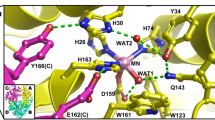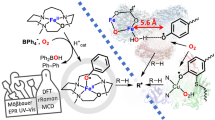Abstract
HAEM proteins are widespread in nature and exhibit diverse biological activities. The properties and function of a given haem protein depend critically on the environment of the haem group. The reactivity of the haem is often influenced by one or more haem-linked ionisable groups. Thus, oxygen affinities of mammalian haemoglobins, for example, exhibit considerable pH dependence (the Bohr effect1). Anion binding to some haem proteins is also a proton-dependent reaction (for example, peroxidase2, catalase2 and leghaemoglobin3,4) whereas for others (myoglobin, haemoglobin1) it is essentially independent of pH. Identification of the ionisable groups which influence the ligand-binding reactions of haem proteins is of fundamental importance in the elucidation of structure/function relationships. Nuclear magnetic resonance (NMR) spectroscopy is one of the most direct methods for observation of titrating groups in proteins. We report here on NMR studies of the nicotinate complex of soybean ferric leghaemoglobin a. On the basis of these studies we propose a role for a haem propionic acid group as a mediator of anion binding.
This is a preview of subscription content, access via your institution
Access options
Subscribe to this journal
Receive 51 print issues and online access
$199.00 per year
only $3.90 per issue
Buy this article
- Purchase on Springer Link
- Instant access to full article PDF
Prices may be subject to local taxes which are calculated during checkout
Similar content being viewed by others
References
Antonini, E. & Brunori, M. Hemoglobin and Myoglobin in their Reactions with Ligands (North-Holland, Amsterdam, 1971).
Pratt, J. M. in Techniques and Topics in Bioinorganic Chemistry (ed. McAuliffe, C. A.) 106–204 (Macmillan, London, 1975).
Ellfolk, N. Acta chem. scand. 15, 975–984 (1961).
Appleby, C. A., Wittenberg, B. A. & Wittenberg, J. B. Proc. natn. Acad. Sci. U.S.A. 70, 564–568 (1973).
Appleby, C. A., Nicola, N. A., Hurrell, J. G. R. & Leach, S. J. Biochemistry 14, 4444–4450 (1975).
Wuthrich, K. Struct. Bonding 8, 53–121 (1970).
Noggle, J. H. & Schirmer, R. E. The Nuclear Overhauser Effect (Academic, New York, 1971).
Balaram, P., Bothner-By, A. A. & Dadok, J. J. Am. chem. Soc. 94, 4015–4017 (1972).
Johnson, R. N., Bradbury, J. H. & Appleby, C. A. J. biol Chem. 253, 2148–2154 (1978).
Ellfolk, N. & Perttila, U. Biochim. biophys. Acta 534, 153–159 (1978).
Harutyunyan, E., Kuranova, I., Grebenko, A., Voranova, A. & Vainshtein, B. Proc. XIth IUPAC Int. Symp. Chem. Natural Products (eds Marekov, N. et al.) 2, 477–481 (1978).
Author information
Authors and Affiliations
Rights and permissions
About this article
Cite this article
TREWHELLA, J., WRIGHT, P. & APPLEBY, C. Molecular basis for proton-dependent anion binding by soybean leghaemoglobin a. Nature 280, 87–88 (1979). https://doi.org/10.1038/280087a0
Received:
Accepted:
Issue Date:
DOI: https://doi.org/10.1038/280087a0
Comments
By submitting a comment you agree to abide by our Terms and Community Guidelines. If you find something abusive or that does not comply with our terms or guidelines please flag it as inappropriate.



